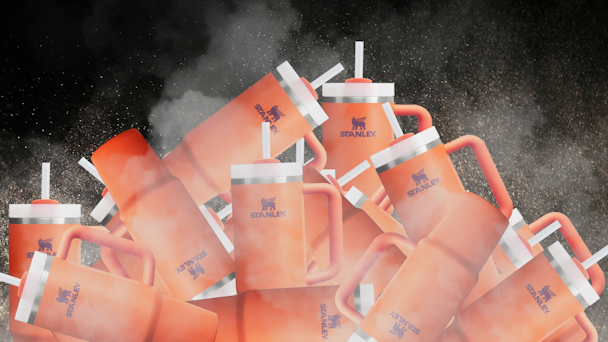We’ve reached peak Stanley. Now the reusable craze needs to be quenched
Reusable water bottle brand Stanley spread like wildfire in 2023 to become a must-have accessory but did the resulting rampant consumerism conflict with any sustainability benefits? Ocean Bottle’s Iona Ratcliffe weighs in.

In the UK just six months ago Chilly’s was our main competition. Then our friends, Stanley came across the pond with a cult following; an army of TikTokking evangelists and collectors. In the US, the reusable bottle category is mature, and the results are showing. In 2023, Stanley went from doing $75m in revenue to $750m. And by January 2024, TikTok videos of Stanley cups had been viewed over 201.4m times. Enviable results, for sure.
What has driven the waterbottle craze?
Back in the UK, in 2023 Mintel found that 79% of Gen Z carry a reusable water bottle. And the cost of living crisis means 40% of consumers reduced their spending on disposable bottles between 2022 and 2023. This should be great news for our ocean and our wallets but something deeper is taking place than the cost of living and environmental consciousness driving purchase behaviors.
Thanks to the likes of Gwyneth and the quantified self-movement hydration has become as fundamental as breathing in oxygen. We’re obsessed with hydration. And we now all know the single-use plastic water bottles are the epitome of toxicity. Bringing single-use plastic into work is like bringing a grumpy skunk into the office.
Advertisement
Water bottles have become an ultimate status symbol, a relatively affordable accessory that says so much about its owner. It’s an extension of your identity and the people you associate yourself with. What’s more, we wear them all the time, just like a phone or wallet or shoe. But even more potent is that you can actually take a selfie while drinking from one.
Enter ambassadors, limited edition collabs with celebrities, scarcity strategies and rainbow color launch drops leaked on TikTok.
But...
The trend is twisted and we as marketers shouldn’t be drinking the kool-aid
Something was and is seriously twisted about this whole thing. An item aimed to do so much good has become a beacon of all that’s wrong with consumerism.
Knowing what we do now about how business, marketing and consumerism is majorly messing up the planet, we have a duty to be responsible, and to think long-term about our strategies. Besides, look at what happened to Stanley. Countless articles titled Peak Stanley flooded news feeds at the end of last year.
Marketers have a duty to use their brand’s platforms to creatively activate climate action in different ways. Also, frankly, if you don’t innovate to differentiate, you’ll die.
The Guardian said it, not I. “If you haven’t followed the trend closely, you’d be forgiven for mistaking a Stanley for a Yeti or a S’well for an Owala – all reusable water bottle brands that have had their moments.”
A reusable water bottle is only a social good if the product in question is actually reused. Furthermore, we need to be thinking about our brands as regenerative business models, more than ever, we need brand people linking up the business across NPD, performance, partnerships, sales and operations. Brand can help redefine a business’s success metrics across environmental, societal and commercial pillars. At the least, sharpen up your footprint with the B Corp framework and, at best, create a brand-led impact strategy.
Advertisement
Our mission at Ocean Bottle is simple, bring people and brands together to end ocean plastic. If those Stanley cups sold last year were Ocean Bottles we could have prevented billions of plastic from going into the ocean. But churning out products that “do good” isn’t just the solution. We’re trying to build a brand that pushes a planet-positive equation. A holistic one that makes a net positive contribution for both people and planet.
Some of the questions we at Ocean Bottle ask ourselves are:
-
All products have a footprint. How can we prioritize recycled materials and low emissions strategies in our supply chain?
-
How can we ensure our products will last? We’ve created initiatives like a product range with a modular system, so people can switch out lids and push our lifetime warranty messaging and spare parts for life scheme.
-
How can we help people see that carrying a reusable is one of the easiest things you can do as individuals?
-
How can we establish channels for change at a policy level? Like our petition to deliver a new network of water fountains and refill stations across the UK and our friends over at City to Sea campaigning to ban single-use in restaurants.
-
How can we get consumers and partners to get smart on the ocean-plastic crisis? We run impact sessions with partners and always start meetings and pitches setting up the context over and above anything else: right now, the rate of plastic production and consumption is only going up, and unless we act now, by 2050 there will be more plastic in weight than fish.
-
How can we think outside the box, finding different revenue streams? Can we allow our customers to fund plastic collection without needing to buy products if they don’t need them? Can we find innovative ways that allow them to do this for free without even paying for it?
From raising awareness about climate change; to lobbying policy makers; to finding new ways to make revenue beyond product; to helping get the ops team the data they need to make informed planet-friendly decisions, the briefs for us marketing folks are endless.

